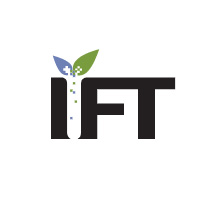Preparing for a Sea of Opportunity
INSIDE ACADEMIA
Research at Virginia Polytechnic Institute and State University can help decrease America’s reliance on imported seafood while enhancing domestic agriculture.
Seafood is an excellent source of lean protein and omega-3 fatty acids, and the taste of well-prepared fish and shellfish is a delight that should be experienced as often as possible. However, fishery production has plateaued, and for some fish species, production is declining. This means that the stock of wild fisheries cannot meet the global demand for seafood. In the United States, 90% of the seafood is imported, and more than half of it is from aquaculture. A sea of opportunity exists to meet the growing demand for seafood in U.S. waters, yet the United States remains a minor player in the aquaculture industry, ranking 16th in aquaculture production. Researchers at Virginia Polytechnic Institute and State University are working to change that, conducting research in aquaculture that would allow the United States to not only produce more of its own seafood but also grow certain land-based crops more sustainably.
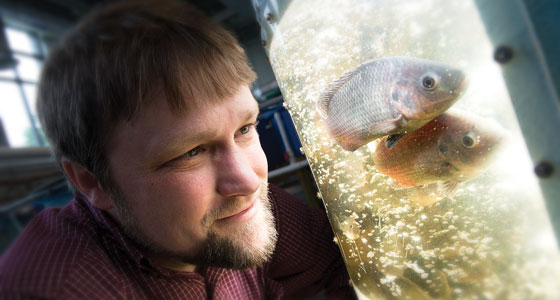 The Significance of Aquaculture
The Significance of Aquaculture
Aquaculture is the controlled breeding, rearing, and harvesting of aquatic animals and plants in all types of freshwater and saltwater environments, including lakes, rivers, and oceans. About half of the seafood consumed around the world is produced through aquaculture; it is the fastest-growing form of food production in the world. While the farming of fish and shellfish is subject to a lot of criticism, it is the only way to meet the global demand for seafood. Natural fisheries will never again be able to supply all the fish humans eat. “When you go to the grocery store, the only thing that’s still from the wild is seafood. Everything else in the grocery store is mostly farmed,” says David Kuhn, an associate professor and extension specialist in the Department of Food Science and Technology at Virginia Polytechnic Institute and State University (Virginia Tech). “And what we’re seeing is as the human population grows globally, we’re putting more and more pressure on the wild fisheries. That is an important industry—don’t get me wrong—but that wild-capture industry cannot keep up with the growing population. So if we want to keep feeding people high-quality, nutritious seafood, we’re going to have to farm more of it.”
Despite what critics say about seafood farming (e.g., farmed seafood is unsafe, has more parasites, contains elevated levels of mercury and other metals, and so on—none of which applies to U.S.-based aquaculture), aquaculture is an environmentally friendly way to feed the planet’s continuously expanding population. More than 99% of the food humans consume comes from terrestrial sources, and less than 1% of human food comes from marine and freshwater sources. The substantial land-based agricultural efforts to feed an expansive global population have resulted in rapid deforestation, soil degradation, greenhouse gases, and the depletion of freshwater resources while food produced solely via water resources remains largely untapped—especially in the United States. “Aquaculture is considered one of the sustainable systems for producing food. This is very important because, right now, by 2050 the population of the earth is going to be close to 10 billion people. We don’t have enough land and we don’t have enough agricultural products and meat to feed people,” says Mahmoudreza Ovissipour, an assistant professor and extension specialist in the Department of Food Science and Technology at Virginia Tech. “Aquaculture can solve the problem.”
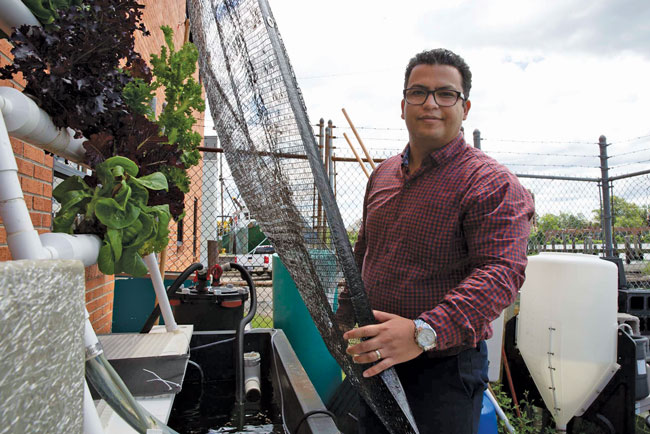 Aquaculture can be used to raise just about any type of seafood, but current aquaculture production encompasses freshwater fish such as catfish, tilapia, and trout; salmon and other saltwater finfish; shellfish such as clams, oysters, and shrimp; eels; and macroalgae (seaweed). Raising different aquatic species requires a variety of methods and aquaculture technologies. “There are different types of aquaculture in the world,” Ovissipour says. “One of them is [the] recirculating aquaculture system, which means you don’t have to add more water into the system, and it works 90% with the same water that you added at the very beginning of your operation.” In recirculating aquaculture systems, fish and other aquatic animals are raised in large land-based tanks. Other land-based aquaculture systems are ponds and raceways. “In the [United States], the catfish industry is well-known for pond aquaculture. In Virginia, … we have pond farmers that do catfish, trout, freshwater shrimp, and hybrid bass in freshwater ponds,” Kuhn says. “The other type of production we have [in Virginia] is raceways. That’s where you take spring water or some kind of mountain-source water, and it just flows through a raceway. That’s typically where we grow things like trout because they need clean, cold water.” Cage aquaculture involves raising finfish in large pens or cages in ponds, rivers, or oceans. “There is risk with that kind of production. You can have a hurricane come through and physically wipe out the operation. You can have disease outbreaks because [the fish] are exposed to the environment,” Kuhn explains. “One way to combat stuff like that is to go indoors [and use] recirculating systems. It is more costly, but you reduce the risk.”
Aquaculture can be used to raise just about any type of seafood, but current aquaculture production encompasses freshwater fish such as catfish, tilapia, and trout; salmon and other saltwater finfish; shellfish such as clams, oysters, and shrimp; eels; and macroalgae (seaweed). Raising different aquatic species requires a variety of methods and aquaculture technologies. “There are different types of aquaculture in the world,” Ovissipour says. “One of them is [the] recirculating aquaculture system, which means you don’t have to add more water into the system, and it works 90% with the same water that you added at the very beginning of your operation.” In recirculating aquaculture systems, fish and other aquatic animals are raised in large land-based tanks. Other land-based aquaculture systems are ponds and raceways. “In the [United States], the catfish industry is well-known for pond aquaculture. In Virginia, … we have pond farmers that do catfish, trout, freshwater shrimp, and hybrid bass in freshwater ponds,” Kuhn says. “The other type of production we have [in Virginia] is raceways. That’s where you take spring water or some kind of mountain-source water, and it just flows through a raceway. That’s typically where we grow things like trout because they need clean, cold water.” Cage aquaculture involves raising finfish in large pens or cages in ponds, rivers, or oceans. “There is risk with that kind of production. You can have a hurricane come through and physically wipe out the operation. You can have disease outbreaks because [the fish] are exposed to the environment,” Kuhn explains. “One way to combat stuff like that is to go indoors [and use] recirculating systems. It is more costly, but you reduce the risk.”
Ensuring Safe and Nutritious Aquaculture Seafood
Reducing risk to aquatic animals and improving the quality of aquaculture products are the primary objectives of Kuhn’s and Ovissipour’s research at Virginia Tech. Both professors and their research teams study land-based aquaculture systems to determine best practices for growing various types of fish, evaluating everything from the type and design of aquaculture systems to nutrition and sensory qualities to optimal food-safety techniques and devices. “Successful aquaculture depends on different things. From management level to site selection, there are many things involved,” Ovissipour says. “Finding the right species to produce depends on the state in which you are located; it depends on the country, the environment, the climate. Finding the right feed for the species, controlling the environment, monitoring the environment, and having a plan for corrective actions if something negative happens in the system—we need to be able to … do this.” Kuhn agrees, adding, “When you’re taking care of live animals, you have to be there seven days a week. You have to have an understanding of many different disciplines. If you don’t have the engineering correct on a system, you’re not going to have an environment that’s appropriate for the animal in terms of water quality and how you manage the feed. So you have to have a real good understanding of how the animal interacts with the environment in a system and how nutrition plays into all of that.”
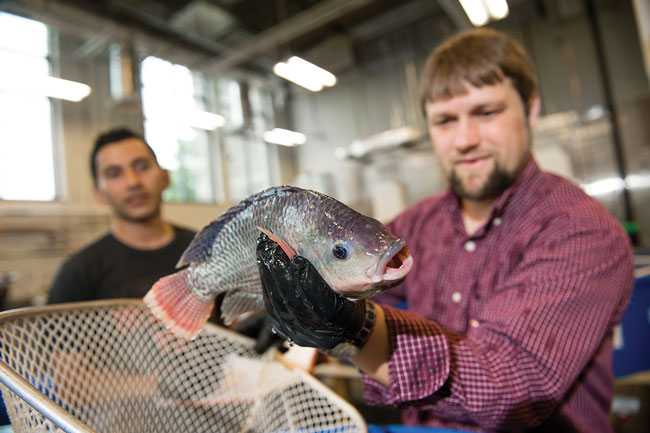 In his lab, Kuhn and his research team design land-based aquaculture systems and grow different fish and shellfish to determine ideal water temperatures and oxygen levels, the best type of feed to improve nutrition, acceptable organoleptic qualities of aquaculture seafood, and other factors related to improving the growth, quality, and yield of aquaculture food products. Kuhn’s lab cultivates a variety of species but has recently been focusing on tilapia, trout, shrimp, pompano, and cobia. “The important things are to minimize the stress to the animal[s] and make sure that they have good nutrition,” Kuhn explains. “They are animals that live in water, so you have to control everything like the temperature, the waste products that come out of the fish, [and so on]. You have to control all those parameters to make sure that you’ve made the conditions great for the fish [and] minimized the stress.” For some fish, minimizing stress includes eliminating crowded conditions in fish tanks and ponds; for other fish, such as tilapia, crowded conditions are ideal for them to thrive, so minimizing fish per tank would be counterproductive. “[Tilapia] like to be close to each other as comfort. If you think about fish, some species of fish like to school, and that’s kind of the way they are naturally,” Kuhn says. Standards for good nutrition also vary according to the species and aquaculture system. “If you raise a catfish in a pond, for example, you can feed them a lower quality feed because they’re also eating things in that pond. They might find natural algae or worms or whatever in that pond and graze on that and eat the feed that we provide,” Kuhn points out. “When you move indoors to a recirculating aquaculture system, it’s more of a sterile environment in terms of feed. [The fish] are in very clear water, so they can’t graze for natural food. So in that case, we have to really make sure that we balance the nutrition in the feed so the fish can be healthy. A healthy fish means no disease outbreaks, and it means fast-growing fish, which is good for economics and food quality.”
In his lab, Kuhn and his research team design land-based aquaculture systems and grow different fish and shellfish to determine ideal water temperatures and oxygen levels, the best type of feed to improve nutrition, acceptable organoleptic qualities of aquaculture seafood, and other factors related to improving the growth, quality, and yield of aquaculture food products. Kuhn’s lab cultivates a variety of species but has recently been focusing on tilapia, trout, shrimp, pompano, and cobia. “The important things are to minimize the stress to the animal[s] and make sure that they have good nutrition,” Kuhn explains. “They are animals that live in water, so you have to control everything like the temperature, the waste products that come out of the fish, [and so on]. You have to control all those parameters to make sure that you’ve made the conditions great for the fish [and] minimized the stress.” For some fish, minimizing stress includes eliminating crowded conditions in fish tanks and ponds; for other fish, such as tilapia, crowded conditions are ideal for them to thrive, so minimizing fish per tank would be counterproductive. “[Tilapia] like to be close to each other as comfort. If you think about fish, some species of fish like to school, and that’s kind of the way they are naturally,” Kuhn says. Standards for good nutrition also vary according to the species and aquaculture system. “If you raise a catfish in a pond, for example, you can feed them a lower quality feed because they’re also eating things in that pond. They might find natural algae or worms or whatever in that pond and graze on that and eat the feed that we provide,” Kuhn points out. “When you move indoors to a recirculating aquaculture system, it’s more of a sterile environment in terms of feed. [The fish] are in very clear water, so they can’t graze for natural food. So in that case, we have to really make sure that we balance the nutrition in the feed so the fish can be healthy. A healthy fish means no disease outbreaks, and it means fast-growing fish, which is good for economics and food quality.”
One of the research projects Kuhn and his team are working on is using probiotics to improve the health and safety of aquaculture fish. Fish have their own microbiomes, but the goal of the research is to enhance their probiotic profile to better protect them from disease. “As we’ve learned recently in the media and through human nutrition, the microbiome of the host (animal or person) is very important to the overall health of the host. I’m … looking at very specific probiotics to see if we can improve the nutrient utilization of feed when you feed the food to them and also provide disease protection,” Kuhn reveals. “In our lab, we’ve shown that disease protection can happen in two ways: You can have the probiotic colonize the intestinal tract and prevent bad bacteria from taking hold in that system. The other way is the probiotics actually modulate or stimulate the immune system of the fish. … So it gears them up for any kind of infection.” The Kuhn lab is also investigating ways to develop fish feed with by-products from other food industries, such as brewers’ grains. “How can we take by-products, improve the quality, and use that in the fish feed is a neat thing to look at because that can also impact the quality of the fish, [and] it can make the overall process more sustainable,” Kuhn says.
In the Ovissipour lab, minimizing stress in aquaculture systems is intertwined with improving food safety. “In a really good aquaculture system, the food safety starts from the aquaculture [side], not the processing [side],” Ovissipour says. “There are many factors that can have a negative impact on growing seafood products in aquaculture systems. … Oxygen is [very] important because if we don’t have enough oxygen in the system, we are exposing fish to [stress], and opportunistic pathogenic bacteria can start growing easily. They can negatively impact the whole population [of fish], and we could lose the whole population. Environmental factors and pathogenic bacteria in the system are related.” The waste products that fish produce are also a chief food-safety concern. “The ammonia level in the system has to be considered. That’s why we have biofilters in the system to convert the ammonia into nitrites and nitrates and control the toxicity in the system and remove it from the system. That’s very important. Temperature is another consideration,” Ovissipour continues. “So temperature, ammonia, and oxygen level are three very important [factors].” There are also other concerns that impact food safety. “For example, the water resources we use can introduce new pathogenic bacteria into the system,” Ovissipour explains. “Technically they are [already] there, but we need to be able to manage them to reduce the level of stress in the system. By controlling the stress in the system, we can reduce the risk of [disease] outbreak in the system. In many cases, [these factors] can pose risks for human consumption.”
Pathogenic bacteria are not unique to aquaculture systems; fish in natural habitats are just as susceptible to harmful microbes as farmed fish are because pathogens are naturally present in most environments. If anything, a properly managed aquaculture system that adheres to U.S. environmental and food-safety regulations may have an advantage when it comes to pathogen control. “Technically, since we have aquaculture as a kind of indoor system or controlled environment, we have better control and monitoring for aquaculture,” Ovissipour asserts. “We can control the pathogenic bacteria in the system, and we are not using fertilizer (in many cases), and we are not introducing any pathogenic bacteria intentionally into the system.” The Ovissipour lab is developing several techniques to rapidly detect and control the presence of pathogenic bacteria in aquaculture systems. These include employing surface-enhanced Raman spectroscopy and nonliving surrogate bacteria to detect pathogens faster and using biobased sanitizers, ultraviolet light, or nanobubbles to kill them. “Nanobubbles have a negative charge. They can easily attach to other materials and reduce surface tension, enhance bacteria removal from surfaces, and expose them to other sanitizers that kill them,” Ovissipour explains. “We are also working on plant-based sanitizers. There are many plant-based components that we can easily extract from plants and [use] them to kill pathogenic bacteria, and they are [generally recognized as safe]. There is no concern or chemical residue after application. And there are also some other chemicals that we can activate when we add them to the solution by using lights. … This project is really important for aquaculture because in a recirculating aquaculture system, [there is] a reactor [in which] you have good bacteria that you don’t want to kill because they are taking care of the water quality. In this case, we can add the compounds, then apply the light, and kill the pathogenic bacteria in a specific location.”
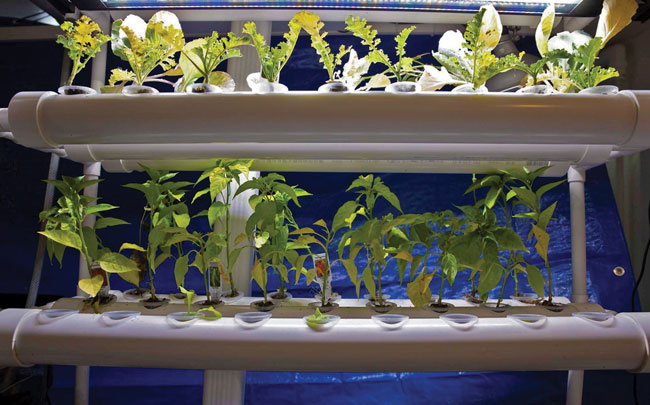 Aquaculture + Hydroponics = Aquaponics
Aquaculture + Hydroponics = Aquaponics
As in the Kuhn lab, sustainability is a primary focus of the Ovissipour lab. Ovissipour and his research team are merging aquaculture with hydroponics, the combination of which is called aquaponics. Aquaponics is the cultivation of plants and aquatic animals symbiotically via a recirculating water system. The fish generate nutrients for the plants via their waste, which then gets converted to nitrates by beneficial nitrifying bacteria. The plants then take up the nitrates to grow. Hence, aquaponics is the integration of fish aquaculture with crop production, thereby combining water conservation with nutrient management in a controlled recirculating system. “There are different types of aquaponics systems. For example, we have aquaponics that we use with marine species, and we have aquaponics that use freshwater species,” Ovissipour says. “For the marine plant, we can [grow] seaweed and algae; for the freshwater aquaponics systems, we [can grow] tomatoes, lettuces, peppers, basil, and [other crops].” Theoretically, one should be able to grow any type of land-based plant via a freshwater-based aquaponics system. While it is possible to grow crops relying solely on the waste products from aquaculture, the growth rate of the plants will be slower. It really depends on the type of plant and how much nutrients it needs. “You always have to have some sort of supplement based on the plant. Some plants can [grow] adequately with aquaculture nutrients; [others] need more specific micronutrients that we don’t have in aquaculture systems, so we need to add them. You don’t have to add them very often, but once in a while, we need to provide those micronutrients. In large operations, they prefer to have de-coupled [systems] and also have another fertilizer [in order] to control plant production.” Ovissipour and his research colleagues are also developing biomaterials from seafood waste material, including bacterial media, fertilizers, cosmetic products, antioxidative peptides, and a protein shake for human consumption.
The research by Kuhn, Ovissipour, and their laboratory teams helps ensure that U.S. aquaculture seafood is safe and that the U.S. aquaculture industry can expand. Right now, the U.S. aquaculture industry is valued at $1.5 billion, which is very small compared to the $100 billion valuation of global aquaculture production. A bigger U.S. aquaculture industry would ensure that more of the seafood Americans consume is produced domestically. “Sometimes when you import seafood, you don’t have a traceability aspect for it. We import aquaculture food, and a lot of it is safe, but there’s the risk that we don’t know where that fish was cultured and how it was cultured,” Kuhn asserts. “[U.S.] aquaculture is … a way to make sure that we can have locally produced food … that is healthy, safe, and traceable.” All vegetables, fruits, grains, beef, pork, and poultry at grocery stores are produced on farms; there is no sensible reason why seafood shouldn’t be too. And with the aquaculture research occurring at Virginia Tech, a sea of opportunity for more safe, sustainable aquaculture in the United States is within reach.

